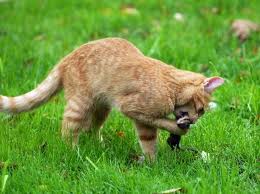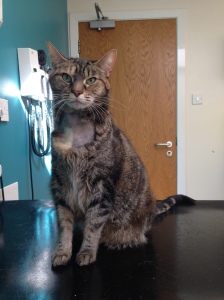I would have to say that my home doesn’t feel complete without one (or more) feline companions. Don’t get me wrong, I love dogs, too (and rats, and horses, and bunnies, and birds, and reptiles, and yes, tarantulas … pretty much any animal), but there is something about cats that has resonated with me since my childhood. Cats can be cool and aloof, snuggly and sweet, playful and silly. And let’s face it, usually lower maintenance than any of the animals I mentioned earlier, which is an attractive feature in a busy household. And I’m not alone in my love of cats. Cats are the most common companion animal in the United States with 30% of households living with 74+ million cats. A recent study even showed that just watching cat videos can make you happier and more productive at work.
With so many cats in the US (and the world) we humans must be doing something right when it comes to the care and feeding of our feline friends, but over the last 10-15 years there has been a push to feed cats what is considered the “natural” diet of the domestic feline and the what and how to feed has become a confusing mess for concerned cat lovers. What is the natural diet of the domestic cat? Cats are obligate carnivores, which mean that they are adapted to a diet that consists of eating other animals, and many people (veterinarians and non-veterinarians alike) advocate feeding a high protein, high fat, and preferably wet food diet to every cat. While this may be ok for a young healthy individual, animals with specific medical conditions such as liver or kidney disease can become very ill when fed a high protein diet. Calorie for calorie, wet food is also more expensive than dry kibble. What about families that cannot afford to feed a wet diet exclusively? Like everything in the nutrition world, the purrfect cat diet (sorry I couldn’t resist) depends on the individual cat and the individual household.
What is the Ancestral Diet of the Cat?
Archeological and genetic evidence indicates that cats began living with humans approximately 12,000 years ago probably after the shift in food production from a hunter-gatherer life-style to that of farmed (and stored) agricultural products. Chances are the small rodents they found among the stored grains came complete with stomachs full of grain bits, too. I would argue that barley and wheat (a couple of the earliest domesticated cereal crops) are natural parts of the cat’s diet, albeit in more limited quantities than what can be found in some dry cat foods. Then 50-60 years ago a dietary shift once again occurred when advances in feline nutrition and food technology led to the development of nutritionally complete commercial dry and canned cat foods. Any amount of (hopefully) fresh meat can be put into a can, but extruder (the machine that makes the kibble) technology set the minimum and maximum amounts of protein and carbohydrate that could be used in dry pet food production. Too much wet meat in the extruder and the dough wouldn’t blend or cook properly; Too little carbohydrate and the kibble wouldn’t stick together. Newer extruders have been developed over the last 10+ years that allow companies to make dry foods with much higher animal protein contents, but to this day many of the “original recipe” dry cat foods on the market will have a lower protein, higher carbohydrates content relative to wet diets because of extruder requirements rather than feline requirements.
Coinciding with this more recent diet shift has been a change in the overall care and husbandry of domestic cats. Cats as a population are spending more time in the safety of our homes with a ready food supply instead of outside defending territory and hunting for prey (such as mice, lizards, small birds, and insects). Indoor-only cats have a decreased risk of exposure to pathogens such as feline panleukopenia and a decreased risk of trauma from vehicles or larger predators, but there is concern in the veterinary profession and among cat owners that this change in diet from a high protein, high moisture, low carbohydrate wild-type diet to a moderate protein, moderate carbohydrate, low moisture diet has contributed to a number of current-day feline diseases, such as obesity, lower urinary tract disease, and diabetes mellitus.
The Influence of Feline Feeding Behavior
Cats, as any cat caregiver knows, are creatures of dietary habit. Research has shown that kitten food preferences are influence by maternal food exposure as well as aspects of the diet itself, such as texture, mouth feel, and aroma. As a cat ages it can demonstrate more food aversions and can resist diet change becoming neophobic (i.e., fearful of new things) even when a diet change is in their best interest. This may be an adaptive response to minimizing risk of food toxicity in the wild, but will frustrate veterinarians and caregivers trying to manage certain medical condition where the feeding of a particular style of food may be recommended (e.g., higher moisture canned foods for cats with a history of sterile cystitis). In addition to specific diet characteristics, environment can influence feeding behavior with many cats experiencing a decrease in food intake during stressful times. Yes, there are some cats that relish the new novel diet, but I would argue that this may be due to unintended training by the caregivers (who doesn’t love a good sale on cat food?) rather than the cat beig inherently adventurous. In an otherwise healthy young cat varying the diet textures and flavors may be the most important feeding strategy a caregiver can make to keep their food preferences flexible. I am not trying to help you feed a kitten, I am trying to help you feed for the entire lifespan of the cat.
Pet Food Manufacturing: Effects on Health and Wellness
Current complete and balanced commercial cat foods are designed to provide adequate levels of all essential amino acids, fatty acids, vitamins, and minerals without the need for supplementation irrespective of diet type. The one exception would be that dry diets provide very little water (8-10% of the volume of a dry food vs. 70-85% of the volume of a wet food) and cats will not simply drink more water to make up the deficit. [This lack of water intake can result in urinary crystals or bladder inflammation in some, but not all, cats.] Even with the perfect diet design, heat and pressure processing (i.e., cooking) that occur during pert food manufacturing can destroy a number of essential nutrients, which will need to be added back in or accounted for by the manufacturer. Even without cooking, fats and fat-soluble vitamins will oxidize and become rancid with exposure to air and minerals will antagonize one another and prevent each other’s absorption. These are well known complications of cooking and food processing that can adversely affect feline health and are hopefully well-known by the pet food manufacturer. But even with all of the nutrition and food science knowledge available to pet food manufacturers mistakes can happen that result in serious harm to companion cats such as when 100% of the added thiamine was degraded during manufacturing. These diets looks perfectly balanced on paper, but deficiencies would have been seen during an Association of American Feed Control Officials (AAFCO) feeding trial or if these manufacturers had tested key nutrients after production of each batch.
“Wild-Type” vs. Dry vs. Canned Diets
A typical well-fed adult house mouse (https://archive.org/details/CAT11124570) is relatively high in moisture (67% moisture as fed), with a crude protein content of 55% on a dry matter (DM) basis, a crude fat level of 24% DM basis, and an estimated carbohydrate content of 8% DM basis. Compare this to a typical over-the-counter adult cat dry food with a lower moisture content (10% moisture as fed), a crude protein level of 34-45% DM basis, crude fat level of 13-20% DM basis, and a carbohydrate content that can range from 8-30% DM basis depending on manufacture and product formulation. The typical over-the-counter adult cat wet diet is a little bit closer, but still not exactly right: Wet diets have a moisture content of 70-85% as fed depending on style, a crude protein content between 40-70% DM basis, a crude fat content of 22-36% DM basis content, and a carbohydrate content that can range from 0-15% DM basis depending on manufacture and product formulation. Just from a simple comparison of a representative “wild-type” prey species, a “typical” dry cat and a “typical” canned cat food, canned diet profile appear to be a closer match the nutrient distribution of a prototypical feline diet. Carbohydrates, both starches and structural carbohydrates (i.e., fiber), are not considered essential nutrients for cats but are essential ingredients for the production of dry cat foods and allow for the formation of a kibble as the ingredients go through the cooking, extrusion, and drying process. Cats are able to metabolize a range of dietary carbohydrate contents whether found in a can or kibble form, and carbohydrates provide a source of non-protein calories that are useful when managing certain medical condition, like kidney disease, when a protein restricted diet is required.
Domestic cats in the wild eat multiple small meals a day (a baby bird here, a cricket there…), and many caregivers will leave dry food out all day to allow their cat or cats to eat at will. While this is a more “natural” feeding pattern for cats, the diets they are grazing on tend to be very palatable and very energy dense (some are 500+ Calories per cup!) and a free-grazing cat can quickly consume more than its daily energy requirement if excess food is available. Some cats are very good at regulating intake, but there is a fat cat in every multi-cat household who ruins it for everyone. Allowing some cats free access to dry food can lead to obesity and its associated complications of diabetes, urinary tract disease, breathing problems, skin disease, and joint disease. Most cats can be trained to eat two to three meals each day with occasional small treats offered in between meals, if extra nibbles are desired, and wet food is especially conducive to portion control.
The Bottom Line…
As with most aspects of diet selection, there is not one perfect approach to feeding cats. Individual animal and caregiver characteristics will influence diet selection and owners should be encouraged to offer a variety of taste and textures early in life to help ensure acceptance of a range of food types as the cat matures. Canned adult maintenance cat foods may be more similar in moisture, crude protein, crude fat and estimated carbohydrate content compared to whole prey (though this is not universally true of all caned cat foods). But, neither a canned cat food nor a dry kibble exactly matches the “wild-type” diet of a domestic cat. Providing a complete and balanced diet, irrespective of diet type, is known to promote health, wellness, and longevity and there is no evidence to support the notion that either canned or dry diets are nutritionally superior for the average healthy adult cat. Dry cat foods are more convenient and economical for owners than canned cat foods, whereas higher moisture canned diets may aid in the medical management of numerous feline maladies. Diet selection should be based on the individual cat and household needs rather than on current diet trends and fads. And don’t forget to keep your cat lean!
Happy Feeding!
Lisa P. Weeth, DVM, MRCVS, DACVN





